![]() IDEAS
IDEAS
![]() Tweet
Tweet
 Vacation
Rentals
Vacation
Rentals
![]()
|
Made With |
|
|
|
|
Dr. Hoffer's Travel WebSite This site was last updated 05/18/13 |
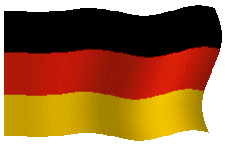

![]() PARIS10 #4 M�NCHEN:
St. Kajetan
PARIS10 #4 M�NCHEN:
St. Kajetan
![]()
bavarian Flag upper right

Thursday, August 19, 2010
I woke at 4:20 and 7:00, and at 9:15 I woke from a v.jpg) ivid dream. I got up
at 11:00 AM planning to get a few things done. Our hotel is a short little
block from the main shopping street, Kaufingerstra�e
and all the downtown action. The route I will take everyday takes me by
the modern little shopping center called
ivid dream. I got up
at 11:00 AM planning to get a few things done. Our hotel is a short little
block from the main shopping street, Kaufingerstra�e
and all the downtown action. The route I will take everyday takes me by
the modern little shopping center called
 . It is full of many
high end shops and cafes and can become a
shortcut to get to Kaufingerstra�e (red line below
right photo.) I don't
know what the
. It is full of many
high end shops and cafes and can become a
shortcut to get to Kaufingerstra�e (red line below
right photo.) I don't
know what the
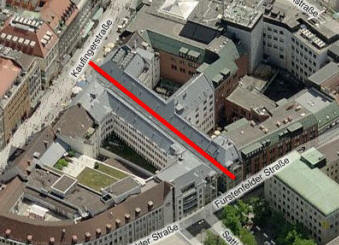 guy is doing up there on the red beam
(left,) but he's always there. I
started ambling about just enjoying being in Munich again. I love the
cleanliness, civility and excitement of this charming big city that feels like a
small town.
guy is doing up there on the red beam
(left,) but he's always there. I
started ambling about just enjoying being in Munich again. I love the
cleanliness, civility and excitement of this charming big city that feels like a
small town.
I came across all the street vendors selling their fruit. It all looked so good I just had to photograph it.
Look at those beautiful cherries (Herzkirschen) and gorgeous grapes (Weinbeeren or Weintrauben) above and the blackberries (Brombeeren) and apricots (Aprikosen) below.
Below left
are these very special Bavarian plums (Zwetschgen)
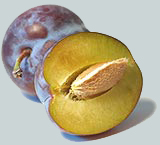 and below right are
nectarines (Nektarinen.)
and below right are
nectarines (Nektarinen.)
There were loads of carts selling raspberries (Himbeeren) and blueberries (Heidelbeeren or Blaubeeren) (below left.)
Then I passed some pastry shops displaying many tempting Bavarian treats (above right & below.) The cakes and tortes were hard to pass up, but I did.
I had to take a shot of these colorful little characters for my granddaughters.
At 11:30 I went into the T-Mobile store and bought a �50 recharge for my phone and �30 for Marcia's. I stopped at the Rosen Apoteke at 11:45 and at noon withdrew some Euro cash from the HypoVereinsbank ATM. As I strolled along the main shopping street, Weinstra�e (below left,) leading out of Marienplatz, I came across the Zwilling cutlery shop [12 Weinstra�e, +49-8-922-2135] and went in and a bought a pair of tiny scissors for �20. I continued on toward the big yellow spires (below right) where I knew I would get to Odeonsplatz.
I finally arrived at my San Francisco Coffee Co.
(from now on SFCC) [Theatinerstra�e
23,
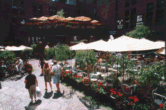
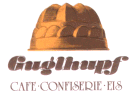 At 2:00, Marcia went for lunch at Caf�
Guglhupf [5 Kaufingerstra�e, +49-89-260-8868] (right, below.) She
enjoyed her favorite salad ni�oise and a hot chocolate.
At 2:00, Marcia went for lunch at Caf�
Guglhupf [5 Kaufingerstra�e, +49-89-260-8868] (right, below.) She
enjoyed her favorite salad ni�oise and a hot chocolate.
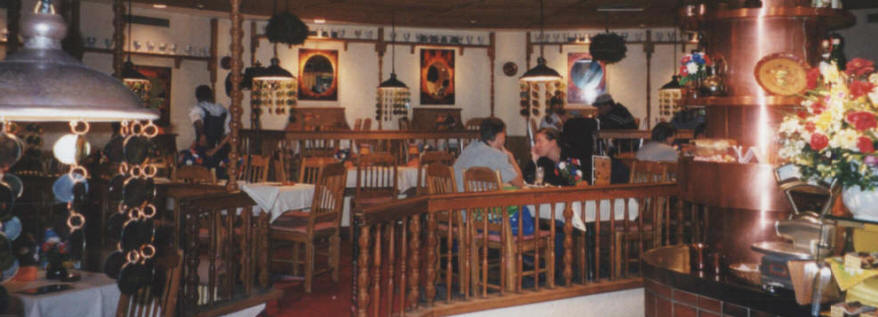
At 4:10 I packed up my computer and headed back to the hotel but then noted that this big beautiful yellow church right next door to the coffee shop was open. I have walked by it (below) a hundred times and photographed it many times for these Diarios but I always thought it was either closed or a converted building. What a surprise I was in store for.
.jpg)
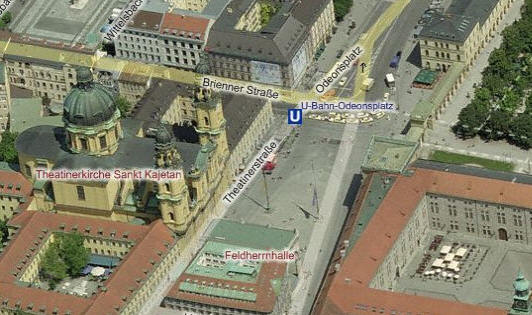
The name of the church is
St. Kajetan
.jpg) (or
Cajetan) Theatinerkirke
(or
Cajetan) Theatinerkirke
.jpg) (above) and it is an active Roman Catholic church. I have
never heard of this saint but he is well known and venerated in Italy, Argentina
and Malta especially by the unemployed and gamblers. Born in Vicenza (near
Venice) in 1480 as Gaetano dei Conti di Tiene, he became a lawyer at age 24.
In 1506 he worked as a diplomat for
Pope Julius II with whom he helped reconcile the Papacy with the
Venetian Republic
(above) and it is an active Roman Catholic church. I have
never heard of this saint but he is well known and venerated in Italy, Argentina
and Malta especially by the unemployed and gamblers. Born in Vicenza (near
Venice) in 1480 as Gaetano dei Conti di Tiene, he became a lawyer at age 24.
In 1506 he worked as a diplomat for
Pope Julius II with whom he helped reconcile the Papacy with the
Venetian Republic
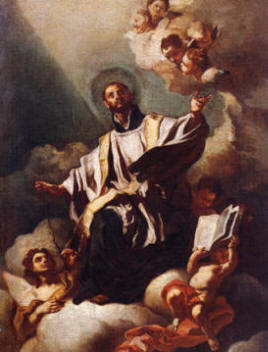
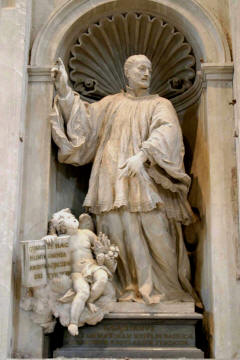 but he was not ordained a priest until the year 1516.
In 1523, he founded the Order of the Clerics Regular which became named
after the Italian city of
Chieti (in
Latin:
Theate),
known as the "Theatines:"
thus Theatinerkirke. I had assumed the name came from the word "theater."
He died in 1547, was beatified on October 8, 1629 by
Pope Urban VIII and canonized on April 12, 1671 by
Pope Clement X. On the right is a painting of him by
Francesco Solimena and left is his statue inside the Vatican in Rome.
but he was not ordained a priest until the year 1516.
In 1523, he founded the Order of the Clerics Regular which became named
after the Italian city of
Chieti (in
Latin:
Theate),
known as the "Theatines:"
thus Theatinerkirke. I had assumed the name came from the word "theater."
He died in 1547, was beatified on October 8, 1629 by
Pope Urban VIII and canonized on April 12, 1671 by
Pope Clement X. On the right is a painting of him by
Francesco Solimena and left is his statue inside the Vatican in Rome.
Remember, the reason we are spending a week here in Munich on this once-a-decade "exception trip" is to make up for never having really toured this great German (Bavarian) city during our 2007 Germany Trip because we ran out of time. This is our 10th time in this city and we have never really "seen" it. So I guess the touring starts now. This was a first for us being here in Munich without our own BMW.
This church was built between 1663 and 1692 by Italian architects, Agostini Barelli and later Enrico Zuccalli (who added the spires.) The front fa�ade was added in 1765 by Fran�ois Cuvillies. As I walked into the church I was suddenly hit by "whiteness." I have been in many churches but have never seen a church this white. It is absolutely spectacular and should not be missed if you visit Munich.
.jpg)
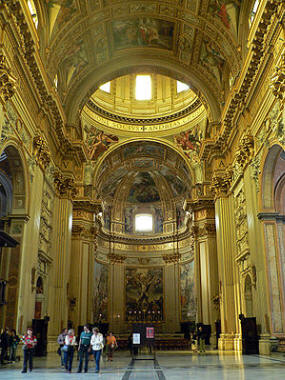
Above left is the view from the back entrance, looking toward the altar. In the center (above) is the view looking back to the entrance door. On the right is a stock photo of the church of San Andrea del Valle in Rome, the Theatine's main church from which this church was modeled. I took shots of the photos they displayed of the way it looked in 1932 (below left,) the restoration work in 1945 after the bombing (center,) and the way it looked in 1973 (right.)
.jpg)
.jpg)
.jpg)
As you walk up the main aisle and look up, you are struck by the beauty and the detail of the white ceiling (below) and...
...then you get to the main dome (below) which is just spectacular.
I get these ceiling shots by placing the camera (with the flash OFF) on the floor in the center of what I want to photograph and put the timer on 10 seconds, push the button and run out of the way. I often have to block people from stepping into the shot. This method eliminates any shaking, allows the shutter to stay open long enough to take a beautiful photograph.
The only thing not white is the great black pulpit (below) which is a work by Andreas Faistenberger (1686.) It is in such stark contrast to the rest of the interior.
At the end of the aisle you face the main altar (below center.) Looking left and right you see the two side aisles (left & right) each with their own altar.
Below is a close up of the apse with the beautiful gold altar and the organ.
They also have these photos of the statuary of Mark and John (below left) which are on the left of the main altar (see above) and Luke and Matthew (below right) which are on the right of the altar. However, if you look at the photo I took above, you can see the statue of Matthew has been replaced by a cardboard silhouette. It must be out for repair.
.jpg)
.jpg)
The two side walls of each of the side aisles is covered with beautiful white statuary of various saints (below) done by Wolfgang Leutner. It really takes your breath away; just the sheer magnitude of it all.
There is also a small chapel here (which I did not see
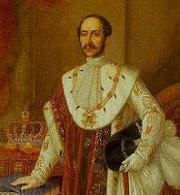 because
I didn't know about it: next time) containing the tomb of
King Maximilian II (left, below left) as well as the tomb (below center) of
his consort Queen
Marie (below right.) They were the parents of two Bavarian kings,
Ludwig II and Otto, both sequentially declared mentally incompetent and deposed.
This must have been tough for her since Ludwig died three years before she did.
There is more on this interesting
Wittelsbach family to explore.
because
I didn't know about it: next time) containing the tomb of
King Maximilian II (left, below left) as well as the tomb (below center) of
his consort Queen
Marie (below right.) They were the parents of two Bavarian kings,
Ludwig II and Otto, both sequentially declared mentally incompetent and deposed.
This must have been tough for her since Ludwig died three years before she did.
There is more on this interesting
Wittelsbach family to explore.
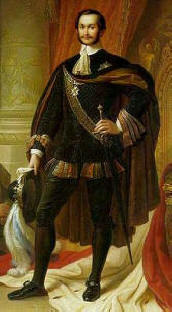
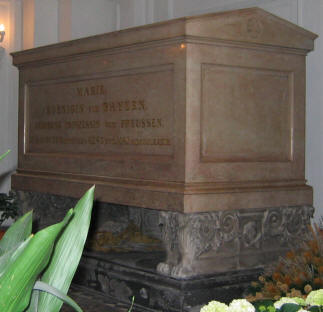
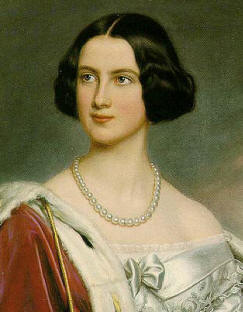
The crypt also contains the Prince�s Tomb, where among others, these members of the Wittelsbach family are buried:
The
church was built by Prince-Elector
Ferdinand Maria (right) and his wife, Henriette Adelaide of Savoy (left,)
Henriette Adelaide of Savoy (left,)
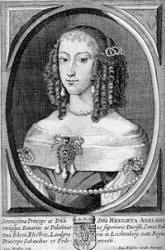 as
a gesture of thanks for the birth of their long-awaited heir to the Bavarian
crown, Prince
Max Emanuel, in 1662. It was built in Italian high-baroque style after
San Andrea del Valle in Rome, the Theatine's primary church (shown above.)
Its Mediterranean appearance and yellow coloring became a well known symbol for
the city and had much influence on Southern German baroque architecture.
In 1664, he commissioned the building of the
Nymphenburg Palace, near Munich; a place we will see later. Her
Italian influence was great in these buildings including bringing opera to
Bavaria.
as
a gesture of thanks for the birth of their long-awaited heir to the Bavarian
crown, Prince
Max Emanuel, in 1662. It was built in Italian high-baroque style after
San Andrea del Valle in Rome, the Theatine's primary church (shown above.)
Its Mediterranean appearance and yellow coloring became a well known symbol for
the city and had much influence on Southern German baroque architecture.
In 1664, he commissioned the building of the
Nymphenburg Palace, near Munich; a place we will see later. Her
Italian influence was great in these buildings including bringing opera to
Bavaria.
At 4:20, I left the church and made a call to finally confirm the two rooms I reserved at Hotel Sirmione in Italy and walked back to the room while taking photos of the Spatenhaus, the Opera House, the Residenz and the Neues Rathaus (New City Hall.) Below is a stock aerial photo of the latter and Marienplatz (left) and a Bing map (right.)

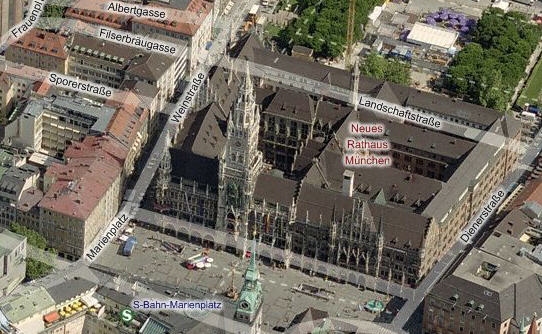
Kaufingerstra�e goes off to the left to Karlsplatz and Weinstra�e starts at the
umbrellas on the left and goes perpendicular to it
toward
Odeonsplatz. Below is a shot of the famous
Bayerischer Hof
hotel [2-6 Promenadeplatz, +49-892-1200.] It is the
white building with the blue awnings. Its a
five-star luxury
hotel with 360 rooms in an
1841 building.
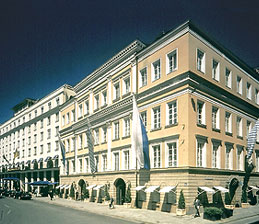 As of 1924, it was the largest hotel in Europe and it has been owned by one
family (the Volkhardts) since 1897. In 1969, the adjacent
Palais Montgelas
(left,) built in 1813, was added to the hotel. The main building is 7
stories plus a public-used basement.
As of 1924, it was the largest hotel in Europe and it has been owned by one
family (the Volkhardts) since 1897. In 1969, the adjacent
Palais Montgelas
(left,) built in 1813, was added to the hotel. The main building is 7
stories plus a public-used basement.
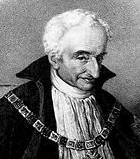 The
cheapest room starts at �400 ($530) a night, a little over my budget.
Below in the park in front of the
hotel, you can see the aluminum sculpture of
Maximilian
Joseph, Count of Montgelas (Savoy) (right,) by the German artist Karin
Sander done in 2005. He was a very important politician who
helped modernize Bavaria. What a schnoz! Check him out.
The
cheapest room starts at �400 ($530) a night, a little over my budget.
Below in the park in front of the
hotel, you can see the aluminum sculpture of
Maximilian
Joseph, Count of Montgelas (Savoy) (right,) by the German artist Karin
Sander done in 2005. He was a very important politician who
helped modernize Bavaria. What a schnoz! Check him out.
I then stopped at the Rosen Apoteke and went up and changed. I started my run from the hotel to Tambosi's at 7:30. Below left is the view, looking back, of the run down Residenzstra�e toward the Residenz (more on that later) (building on the left.)
.jpg)
I ran inside the entrance to the Residenz and took this photo (above right) of an EU map with certain countries marked in brown. I know why Switzerland was excluded but can not explain Belgium, Portugal, Czech Republic and Slovakia. Below left is the main entrance to the Residenz and right across the street is the Feldherrenhalle (Hall of Heroes.)
Overview of Odeonsplatz: Google (left) and Bing (right.)
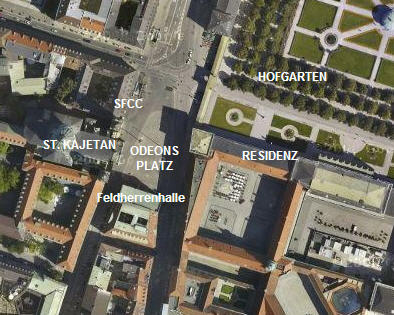

The statues inside are of military leaders Johann Tserclaes, Count of Tilly (1559�1632) who fought in the Thirty Years War (below left) and...
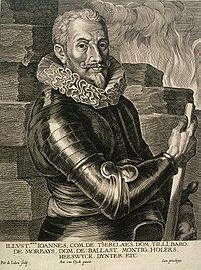
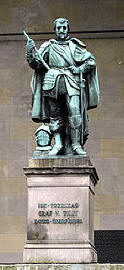
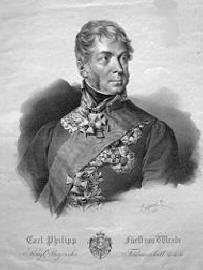
...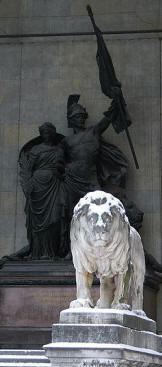 Karl
Philipp von Wrede (1767�1838) (above right.) Wrede represented Bavaria
at the
Congress of Vienna and was the leading Bavarian soldier of his day.
The central sculptural group (left) was added in 1882, after the
Franco-Prussian War.
Karl
Philipp von Wrede (1767�1838) (above right.) Wrede represented Bavaria
at the
Congress of Vienna and was the leading Bavarian soldier of his day.
The central sculptural group (left) was added in 1882, after the
Franco-Prussian War.
Regarding this place, I have mentioned the "Hitler incident" in past Diarios, but here is the whole story. On Friday morning, November 9, 1923, the Feldherrnhalle was the scene of a confrontation between the Bavarian State Police and an illegally organized march by the followers of Adolf Hitler. When ordered to stop, the marchers continued. The State Police felt threatened and opened fire. Four policemen and sixteen marchers were killed and a number were wounded, including Hermann G�ring (in the leg and groin.) Hitler ran away leaving the others like Ludendorff to be arrested. As a result, Hitler was arrested later and sentenced. This was one of the efforts by the Nazis to take over the Bavarian State, commonly referred to as the "Beer Hall Putsch."
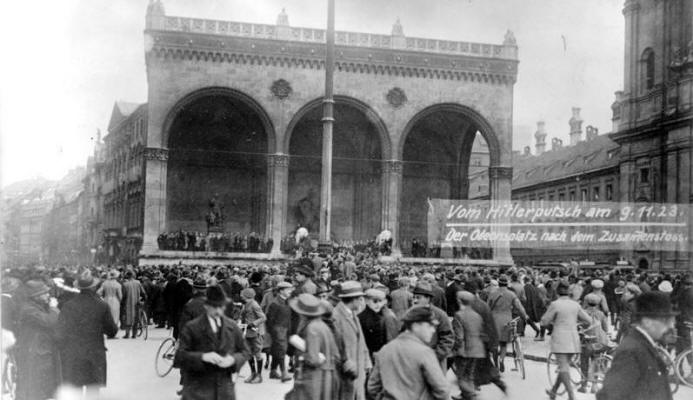
There was a much-publicized trial with a sympathetic judge. Below is the photo taken of the defendants. Ludendorff (below in center,) the WWI hero that had participated, was acquitted while Hitler (to his left) and Hess were both sentenced to five years in Festungshaft prison. Hitler only served a little over eight months.
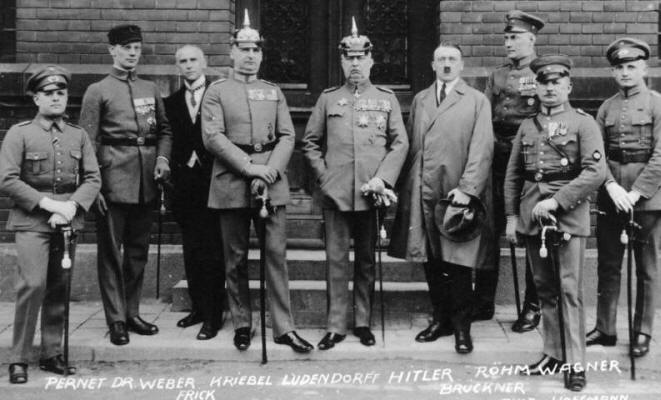
Though Hitler failed to achieve his immediate stated goal, the event did give the Nazis their first exposure to national attention and a propaganda victory. While serving his prison sentence at Landsberg am Lech, he and Rudolf Hess wrote Mein Kampf.
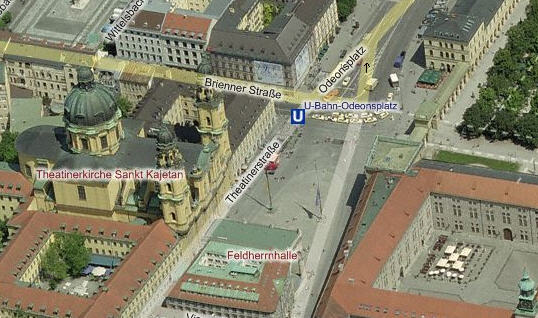
Above is a Bing map of Odeonsplatz (above) with St. Kajetan on the left, Feldherrenhalle in the center and the Residenz on the right. The Feldherrenhalle (Field Marshall's Hall) was constructed between 1841 and 1844 in the spot where the Gothic Schwabinger Tor (gate) was demolished. This was one of the major gates into the city when it was walled. This would be a good place to describe the wall (mauer in German)and these historic gates (toren.)
During the Middle Ages, Altstadt (Munich's historic center,) was protected by a
city wall that featured four lar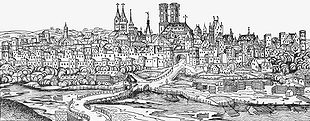 ge
tower gates as well as five smaller ones. The fortification was built
between 1285 and 1347 and replaced a smaller inner city wall, known as the
Innere Stadtmauer (built in the 12th Century.) The new wall was known as
the �u�ere (outer) Stadtmauer (city wall.) Above is a small drawing of how
Munich looked in 1493. Its view from the east.
ge
tower gates as well as five smaller ones. The fortification was built
between 1285 and 1347 and replaced a smaller inner city wall, known as the
Innere Stadtmauer (built in the 12th Century.) The new wall was known as
the �u�ere (outer) Stadtmauer (city wall.) Above is a small drawing of how
Munich looked in 1493. Its view from the east.
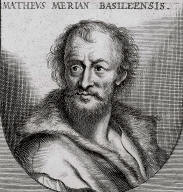 Here below is an etching by Matth�us Merian the Elder (1593-1650) (right) of the
way Munich Altstadt looked in the year 1650. I left it large to show the
details of the buildings. You can see the fortified walls and the moat
around the city fed by the Isar River on the right. See if you can find
the twin onion-domed Frauenkirke cathedral and the little pole holding up the
statue of Mary in Marienplatz. You can also see the towers of St.
Michael's and of St. Peter's.
Here below is an etching by Matth�us Merian the Elder (1593-1650) (right) of the
way Munich Altstadt looked in the year 1650. I left it large to show the
details of the buildings. You can see the fortified walls and the moat
around the city fed by the Isar River on the right. See if you can find
the twin onion-domed Frauenkirke cathedral and the little pole holding up the
statue of Mary in Marienplatz. You can also see the towers of St.
Michael's and of St. Peter's.

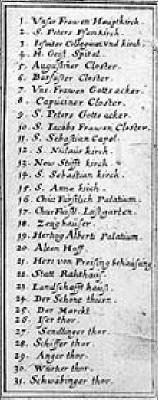
Below is a present-day map of Munich Alstadt, roughly showing the location of the wall (black line,) moat (blue lines) and the original gates of the city (brown squares.) [1] is the Hintere (rear) Schwabinger gate and [2] is the Vordere (anterior) Schwabinger gate. The blue arrows show the moat's water flow direction.
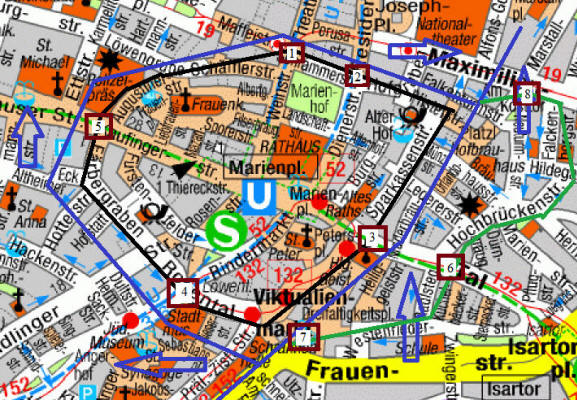
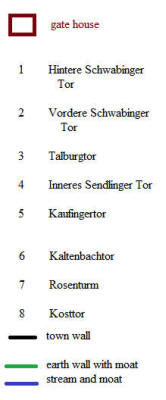
[4] is the Sendlinger Tor and [5] is the Karlstor. The Rosenturm (see later) is [7] and the Kosttor is [8]. During the 18th century the population of Munich started to grow steadily and the fortification hindered further expansion of the city. In 1791 the Elector of Bavaria, Karl Theodor, decided to tear down the wall encircling the city. There are only three gate-towers remaining today.
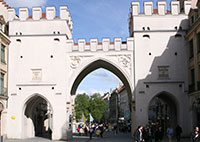 The Karlstor (right, today) was originally known as the
Neuhauser Tor but was renamed in 1797 after Karl Theodor. The Elector
created a new square near the Karlstor, officially known as Karlsplatz (see
later) but still often referred to as Stachus. It is located at the end of
Kaufingerstra�e which is why it is labeled Kaufingertor above on the map.
The Karlstor (right, today) was originally known as the
Neuhauser Tor but was renamed in 1797 after Karl Theodor. The Elector
created a new square near the Karlstor, officially known as Karlsplatz (see
later) but still often referred to as Stachus. It is located at the end of
Kaufingerstra�e which is why it is labeled Kaufingertor above on the map.
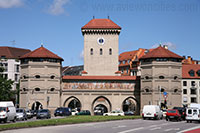 The Isartor (right, today) is
The Isartor (right, today) is
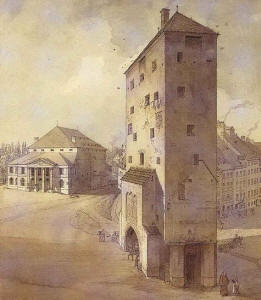 located
just west of Marienplatz, at the end of what is known as the Tal (valley).
The street leading through the gate (Im Tal) was given this name because the
road from the Altes Rathaus
located
just west of Marienplatz, at the end of what is known as the Tal (valley).
The street leading through the gate (Im Tal) was given this name because the
road from the Altes Rathaus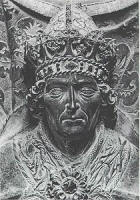 (Old Town Hall) towards the Isartor went downhill. The central tower was
built in 1337 (left, as it appeared in 1829) and gave entrance to the
Isar River. The
smaller octagonal towers were built later (early 15th century.) The fa�ade
of the Isartor is decorated with murals depicting the triumphal procession of
Louis the Bavarian
(Ludwig IV, Holy Roman Emperor, right) after his victory over the Austrians at
the battle of Ampfing in 1322.
(Old Town Hall) towards the Isartor went downhill. The central tower was
built in 1337 (left, as it appeared in 1829) and gave entrance to the
Isar River. The
smaller octagonal towers were built later (early 15th century.) The fa�ade
of the Isartor is decorated with murals depicting the triumphal procession of
Louis the Bavarian
(Ludwig IV, Holy Roman Emperor, right) after his victory over the Austrians at
the battle of Ampfing in 1322.
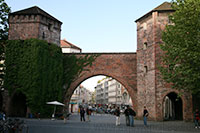
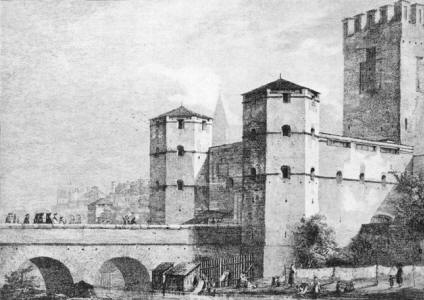 ining
gates; presumably built in 1318. It was the gateway for the trade
route to Italy. The tall central tower (left, as it was in 1800) was
demolished in 1808 and in 1906 the three arches that connected the two outer
towers were replaced by a single large arch which enabled cars to pass
through. At the same time two smaller gates were created in the
hexagonal towers for pedestrians.
ining
gates; presumably built in 1318. It was the gateway for the trade
route to Italy. The tall central tower (left, as it was in 1800) was
demolished in 1808 and in 1906 the three arches that connected the two outer
towers were replaced by a single large arch which enabled cars to pass
through. At the same time two smaller gates were created in the
hexagonal towers for pedestrians.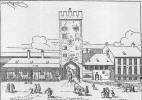 The Schwabinger Tor (left) was built in 1391 near the
current
Odeonsplatz. Like many smaller towers
that were part of the city walls, it was demolished at the beginning of the
19th century to facilitate the expansion of the city. It no longer
exists but a new development is being built in the outskirts of the city and
it has been named Schwabinger Tor. Below are some etchings of the two
towers; Vordere (anterior) Schwabinger Tor (below left) and Hintere (rear)
Schwabinger Tor (below right) from the early 1800s.
The Schwabinger Tor (left) was built in 1391 near the
current
Odeonsplatz. Like many smaller towers
that were part of the city walls, it was demolished at the beginning of the
19th century to facilitate the expansion of the city. It no longer
exists but a new development is being built in the outskirts of the city and
it has been named Schwabinger Tor. Below are some etchings of the two
towers; Vordere (anterior) Schwabinger Tor (below left) and Hintere (rear)
Schwabinger Tor (below right) from the early 1800s. 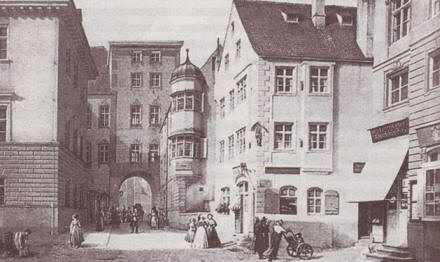

Below are two more I found of Swabinger Tor, obviously from different eras.
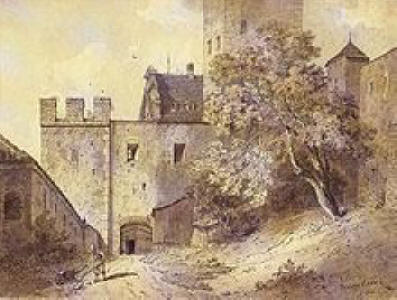
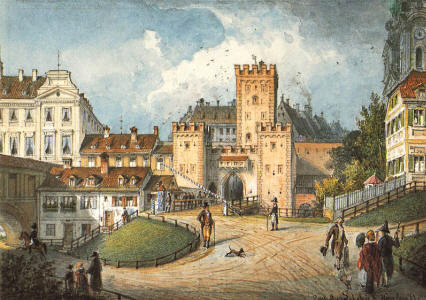
That's enough for gates. When I finished photographing, at 8:00, I went to the German electronic store, Saturn [Kaufingerstra�e] (below left) and bought a new charging plug for my Nokia cell phone for �15. The one I had stopped working. Then, it never hurts to drop into the Augustiner Bra� M�nchen (below right) for a refreshing helles.
Its touristy, of course, but its fun and the bier is real. On the way back to the room, I passed another confectionary with these cute little chocolate pigs called Wildschwein mit Marzapan for �4.5 ($6)/st�ck (piece,) a little dear for my taste.
I arrived back at the room and got changed for dinner. At 8:55 we got
 the
cab we ordered and headed to dinner at a restaurant that was highly recommended
by my friend and colleague, Dr. Thomas Neuhann (see later.) It was a ways
out of the Altstadt easterly in a residential neighborhood (orange pin below) and the cab driver had a very hard time
finding it.
the
cab we ordered and headed to dinner at a restaurant that was highly recommended
by my friend and colleague, Dr. Thomas Neuhann (see later.) It was a ways
out of the Altstadt easterly in a residential neighborhood (orange pin below) and the cab driver had a very hard time
finding it.
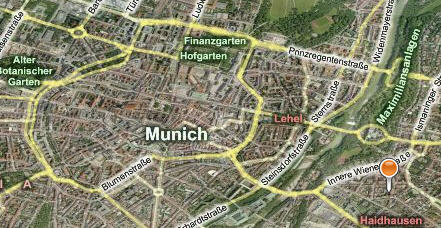
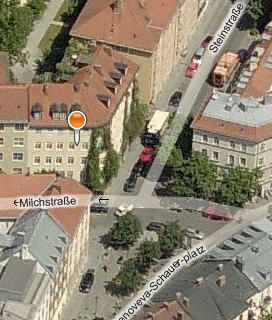
It is called Vinaiolo [42 Steinstra�e, +49-894-895-0356.]
Above left is the entrance (which can be seen in the Bing map above) and on the right is one of the dining rooms on the left side of the building. We were seated at a nice table (below left) in the center of the other room on the right side.
Their menu was very small with only nine items total including only four entrees. We ordered a bottle of San Pellegrino and a bottle of Italian white wine, Le Vaglie Verdicchio dei Castelli Jesi, Santa Barbara Winery'08 (very good.)
.jpg)
.jpg)
I had to
order my favorite dish from Rome, stuffed fried zucchini flowers (fiori di
zucchine ripieni su crema di melanzane) (above right) but I didn't enjoy them
here that
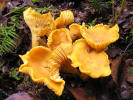 much. Then, due to the meager choices, for an entree I ordered
something unusual for me,
gnocchi di patate con finferli e ragout di coniglio (potato gnocchi with
pfifferling (chanterelle)
mushrooms (left) in a rabbit sauce) (below left.) Marcia had filetto di
branzino con zucchine e insalata di finocchio (Italian sea bass filets with
zucchini and fennel salad) (below right.)
much. Then, due to the meager choices, for an entree I ordered
something unusual for me,
gnocchi di patate con finferli e ragout di coniglio (potato gnocchi with
pfifferling (chanterelle)
mushrooms (left) in a rabbit sauce) (below left.) Marcia had filetto di
branzino con zucchine e insalata di finocchio (Italian sea bass filets with
zucchini and fennel salad) (below right.)
Marcia also had their only Zuppa, a gazpacho con sfogliatini di mousse al parmigiano (below.)
We rated the place from good to excellent.
.jpg) Before
we leave, I have to show you something interesting I found in the bathroom.
Above the facilities, they have on/off valves for the hot and cold water
(right.) Below them are gauges that monitor the amount of water used (in m3;)
a red one for the hot water (below left) and a blue one for the cold (below
right.) I assume they are to keep track of what they owe for the water
used. It says Istameter Radio, so I also assume they "radio" the readings
to a central monitor. I have never seen this before.
Before
we leave, I have to show you something interesting I found in the bathroom.
Above the facilities, they have on/off valves for the hot and cold water
(right.) Below them are gauges that monitor the amount of water used (in m3;)
a red one for the hot water (below left) and a blue one for the cold (below
right.) I assume they are to keep track of what they owe for the water
used. It says Istameter Radio, so I also assume they "radio" the readings
to a central monitor. I have never seen this before.
.jpg)
.jpg)
At 10:15 they called a cab for us to take us back to the hotel. After we got back, I wanted to show Marcia a cute little place nearby that I found on today's run. So at 11:00, we walked over to Caf� Bricelta [3a Kreuzstra�e, +49-892-322-5871.]
.jpg)
.jpg)
We ordered a glass of Austrian Gr�ner Veltliner wine and a glass of Prosecco followed by a cappuccino and a liter of cokalite. They specialize in Iberian food.
Our waitress was very nice and she gave us free slices of cold watermelon (below left.) So, we had dessert after all.
We walked back to the hotel at 11:45 and I took this shot of the beautiful Asamkirche at night (above right) with the Asamhaus on the left. Back at the hotel we enjoyed a glass of wine in the lobby while talking to our friend Dirk, on the desk. We got to bed at 3:15 AM.
Kenneth J. Hoffer, MD
Munich, Germany
8/19/2010
Sent 1-27-2011
If you enjoyed these travels or wish to add comments on the places we visited
Please Leave Me a Message by clicking the spinning @ sign below.

